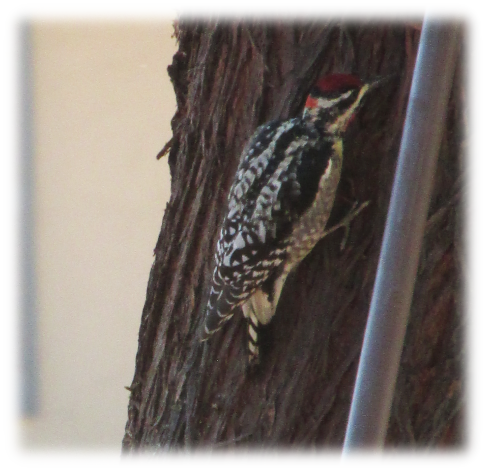
For me and birdwatching, it all started a few years ago, when I glanced out my back door and saw a bird I didn't recognize - something different from the sparrows, grackles, and doves that I was used to. Half an hour with Google and Wikipedia later, I had an identification, and the start of a new hobby. This is a partial list of birds I've been able to enjoy watching from the comfort of my own home.
| Bird Species | Description/Notes |
|---|---|
| Abert's Towhee | Mid-size brown bird with dark feathers around the eye. Scratches at the dirt to forage for food with a distinctive dance-like hopping motion. This is the bird that got me started with birdwatching! |
| Lesser Goldfinch | Barely larger than a hummingbird. Yellow underside ranging from somewhat dull to very bright. Males have a dark cap, and back feathers that are black in the eastern color morph, olive green in the western morph. Here in Arizona, we have the western form. |
| House Finch | You've probably heard these birds all your life without realizing! Very common sparrow-sized finches, males show yellow-orange to red pigmentation on face and breast - this pigment comes from their food, so a bright red male is very well fed! Females look a lot like sparrows, but can be told apart by the streaky feathers on their underside. |
| Brown-Headed Cowbird | Medium-sized stocky black bird with a brown head and conical beak. Easily identified by their unusual, liquid-sounding "glug-glug-GLEE" call. These birds are actually brood parasites, like cuckoos - they lay their eggs in other birds' nests to be raised by them! |
| Rosy-faced/Peach-faced Lovebird | Bright green small parrots with blue tails and a peach-colored face. Once captive birds, they have become naturalized in the Phoenix area, taking advantage of the relative abundance of food and shelter to be found in our urban environments. |
| Red-naped Sapsucker | Pictured to the right! A fairly uncommon woodpecker - it was a real treat to have one visit my yard. |
| Curve-billed Thrasher | Brown birds with golden eyes and a curved bill that gives them their name. They have a very loud, up-and-down three-note call you may have heard before without knowing what made it! |
| Rock Dove | You may not have heard them called that, but you've definitely seen them: these are the big gray pigeons with iridescent neck feathers that you see everywhere in the city. "Dove" and "pigeon" are actually two interchangeable names for any bird in the family Columbidae. Rock doves also have a history you might not know about: they are actually the feral descendants of domesticated pigeons that were raised for their eggs and meat! They might have a reputation as unwanted nuisances, but they started out as a dependable friend to humankind. |
| Mourning Dove | Exceedingly common mid-size dove. Brown overall with darker spots on the wings. They sound like they're chirping when they fly, but that noise is actually air whistling through their feathers! |
| Eurasian Collared Dove | Large, pale dove with a distinctive thin black "collar" on the back of their neck. Technically another invasive species, but fortunately they're not noticeably outcompeting the natives. |
| Yellow-rumped Warbler | These sparrow-sized birds, overall greyish with streaks of black and white, may be named for the yellow patch just above their tail - but you can also see flashes of yellow on their throat, forehead, and shoulders! |
| Verdin | Small, fast, and inconspicuous, these songbirds are easy to miss for how common they are! Mostly grey, with a dusty yellow face and a small rust-red patch on the shoulder. The males build several enclosed nests with a single well-protected entrance, and the female chooses the one she likes best to lay her eggs in. |